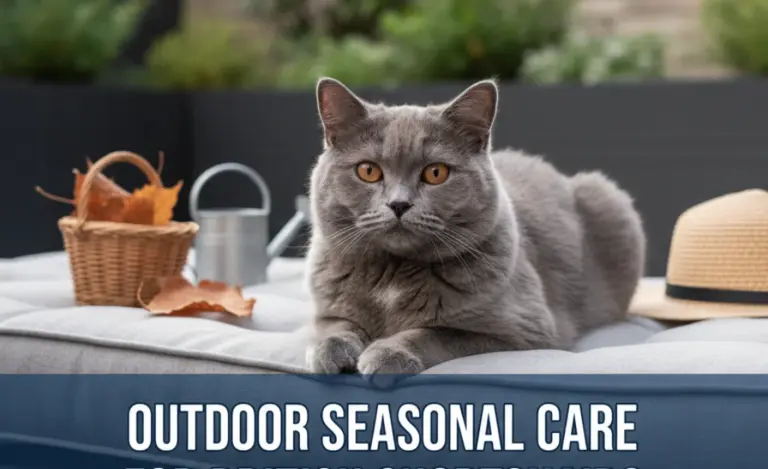Indoor Temperature Hazards for British Shorthairs: Ultimate Guide
Quick Summary: British Shorthairs are adaptable but sensitive to extreme temperatures. Overheating can cause heatstroke, with symptoms like panting and lethargy. Hypothermia from cold leads to shivering and weakness. Maintain a comfortable indoor temperature (68-78°F or 20-26°C), provide shade and water in summer, and warm bedding in winter. Monitor your cat’s behavior and adjust the environment to ensure their safety and well-being.
As a British Shorthair owner, you know these cats are more than just beautiful; they’re family. And like any family member, you want to keep them safe and comfortable. One often-overlooked aspect of their well-being is indoor temperature. British Shorthairs, with their plush coats, can be surprisingly vulnerable to temperature extremes. Overheating or getting too cold can lead to serious health issues. It can be worrying to think about, but don’t worry! This guide will walk you through how to keep your British Shorthair purr-fectly comfortable year-round. We will cover ideal temperatures, signs of distress, and simple steps to create a safe and cozy home for your feline friend.
Understanding Temperature Sensitivity in British Shorthairs
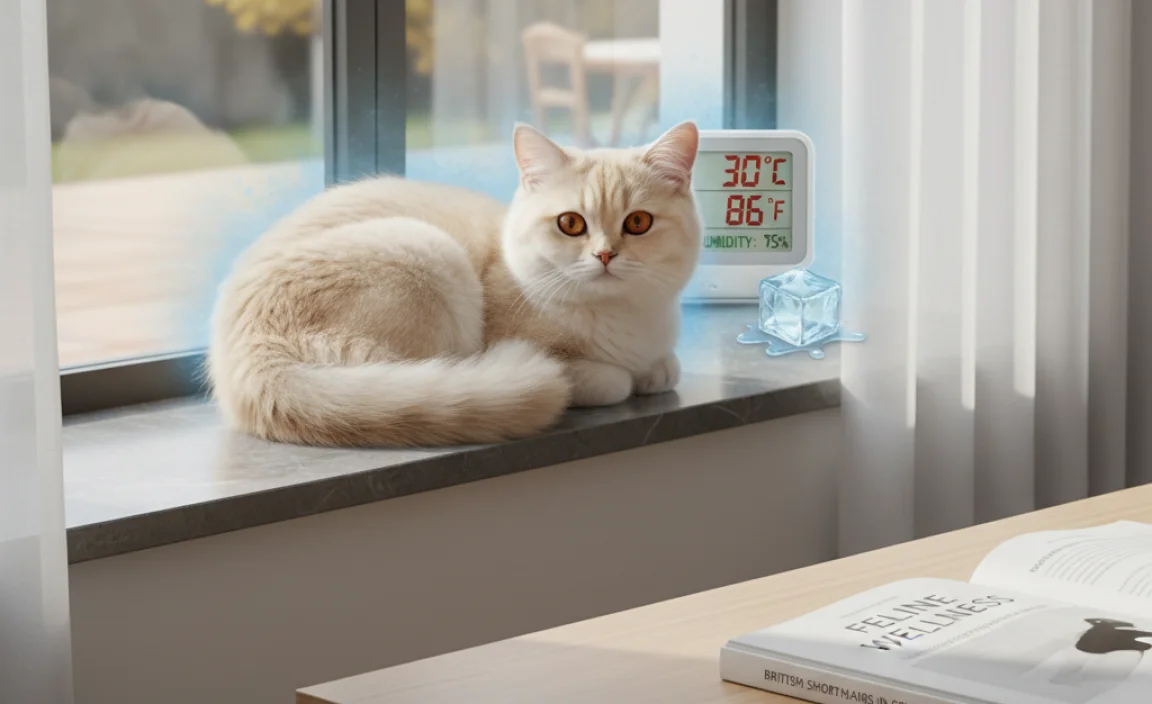
British Shorthairs have a dense, plush coat that helps them stay warm in cooler weather. However, this same coat can make them susceptible to overheating in warmer conditions. Unlike humans, cats don’t sweat effectively to cool down, relying primarily on panting, which is less efficient. Understanding these breed-specific factors is crucial to preventing temperature-related health issues.
How Their Coat Affects Temperature Regulation
The British Shorthair’s coat is designed to insulate. In winter, it traps warm air close to their body, keeping them cozy. But in summer, that same insulation can trap heat, making them prone to overheating. Think of it like wearing a fur coat in July – not very comfortable!
- Insulation in Winter: Dense fur traps warm air.
- Heat Retention in Summer: Fur prevents efficient cooling.
- Limited Sweating: Cats primarily pant to cool down.
Ideal Temperature Range for British Shorthairs
The ideal indoor temperature range for British Shorthairs is similar to what’s comfortable for most humans: between 68°F and 78°F (20°C and 26°C). However, individual cats may have slightly different preferences based on their age, health, and activity level. Kittens and senior cats, for example, may prefer slightly warmer temperatures. Regularly check on your cat to make sure they are comfortable.
Here’s a quick guide:
- Ideal Range: 68°F – 78°F (20°C – 26°C)
- Kittens & Seniors: May prefer slightly warmer temps.
- Monitor: Observe your cat’s behavior for clues.
The Dangers of Overheating (Hyperthermia)

Hyperthermia, or overheating, is a serious condition that can be life-threatening for British Shorthairs. Because they don’t sweat efficiently, they rely on panting to cool down, which isn’t always enough in hot environments. Recognizing the signs of overheating and taking swift action is essential.
Recognizing the Signs of Overheating
Early detection is key. Watch for these signs:
- Excessive Panting: More rapid and shallow breaths than usual.
- Lethargy: Unwillingness to move or play.
- Drooling: Increased salivation.
- Red Gums and Tongue: Indicating increased body temperature.
- Restlessness: Inability to settle down.
- Vomiting or Diarrhea: Can occur in severe cases.
- Seizures: A critical sign requiring immediate veterinary attention.
Immediate Steps to Take If Your Cat Is Overheating
If you suspect your British Shorthair is overheating, act quickly:
- Move to a Cooler Area: Get your cat out of direct sunlight and into an air-conditioned or shaded space.
- Apply Cool Water: Use a damp cloth to gently cool their ears, paws, and belly. Avoid using ice water, as this can cause shock.
- Offer Water: Encourage your cat to drink small amounts of cool (not ice-cold) water.
- Fan Them: Use a fan to circulate air around your cat.
- Seek Veterinary Care: Even if your cat seems to recover, it’s crucial to consult a vet to rule out any complications.
Preventative Measures to Avoid Overheating
Prevention is always better than cure. Here’s how to keep your British Shorthair cool:
- Air Conditioning: Maintain a comfortable indoor temperature during hot weather.
- Shade: Provide shaded areas indoors, away from direct sunlight.
- Water: Ensure fresh, cool water is always available. Consider a water fountain to encourage drinking.
- Cooling Mats: These provide a cool surface for your cat to lie on.
- Avoid Strenuous Activity: Limit playtime during the hottest parts of the day.
- Grooming: Regularly brush your cat to remove excess fur, which can trap heat.
The Dangers of Getting Too Cold (Hypothermia)
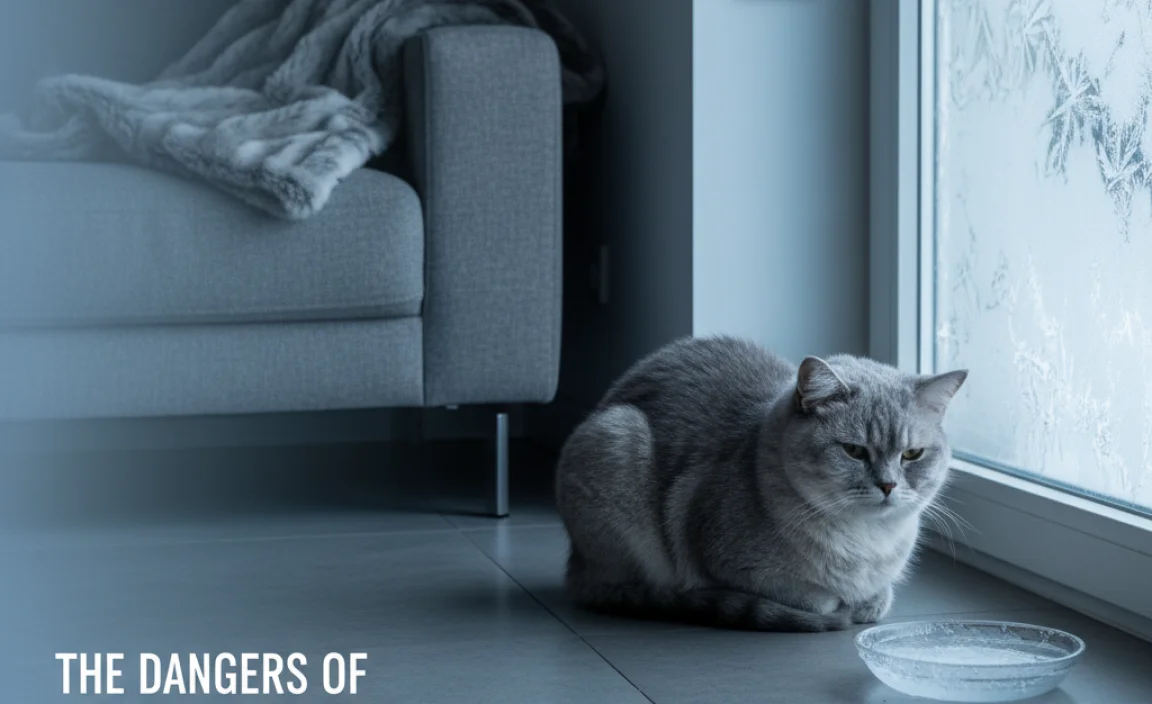
While British Shorthairs have a thick coat, prolonged exposure to cold temperatures can lead to hypothermia. This condition occurs when a cat’s body temperature drops too low, impairing normal bodily functions. Recognizing the signs of hypothermia and taking prompt action can save your cat’s life.
Recognizing the Signs of Hypothermia
Keep an eye out for these symptoms:
- Shivering: Persistent and uncontrollable shivering.
- Lethargy: Weakness, drowsiness, and reduced activity.
- Muscle Stiffness: Difficulty moving or walking.
- Pale Gums: Indicating poor circulation.
- Slow Breathing: Reduced respiratory rate.
- Cold Ears and Paws: Cool to the touch.
- Unresponsiveness: In severe cases, the cat may become unresponsive.
Immediate Steps to Take If Your Cat Is Too Cold
If you suspect your British Shorthair is hypothermic, take these steps immediately:
- Move to a Warm Area: Bring your cat indoors to a warm room.
- Wrap in a Blanket: Use a warm blanket to gradually raise their body temperature. Avoid using a heating pad directly on their skin, as this can cause burns.
- Warm Towels: You can gently warm towels in the dryer and wrap them around your cat.
- Offer Warm Fluids: If your cat is alert, offer small amounts of warm (not hot) water or diluted chicken broth.
- Seek Veterinary Care: Hypothermia can be life-threatening. Contact your vet immediately for guidance and treatment.
Preventative Measures to Avoid Hypothermia
Protect your British Shorthair from the cold with these precautions:
- Indoor Housing: Keep your cat indoors during cold weather.
- Warm Bedding: Provide a warm, comfortable bed away from drafts.
- Insulated Cat Houses: If your cat spends time outdoors, provide an insulated cat house.
- Avoid Drafts: Ensure your home is free from drafts.
- Monitor Outdoor Time: Limit outdoor time during cold weather.
- Extra Food: Cats require more calories during winter to maintain their body heat.
Creating a Comfortable Indoor Environment
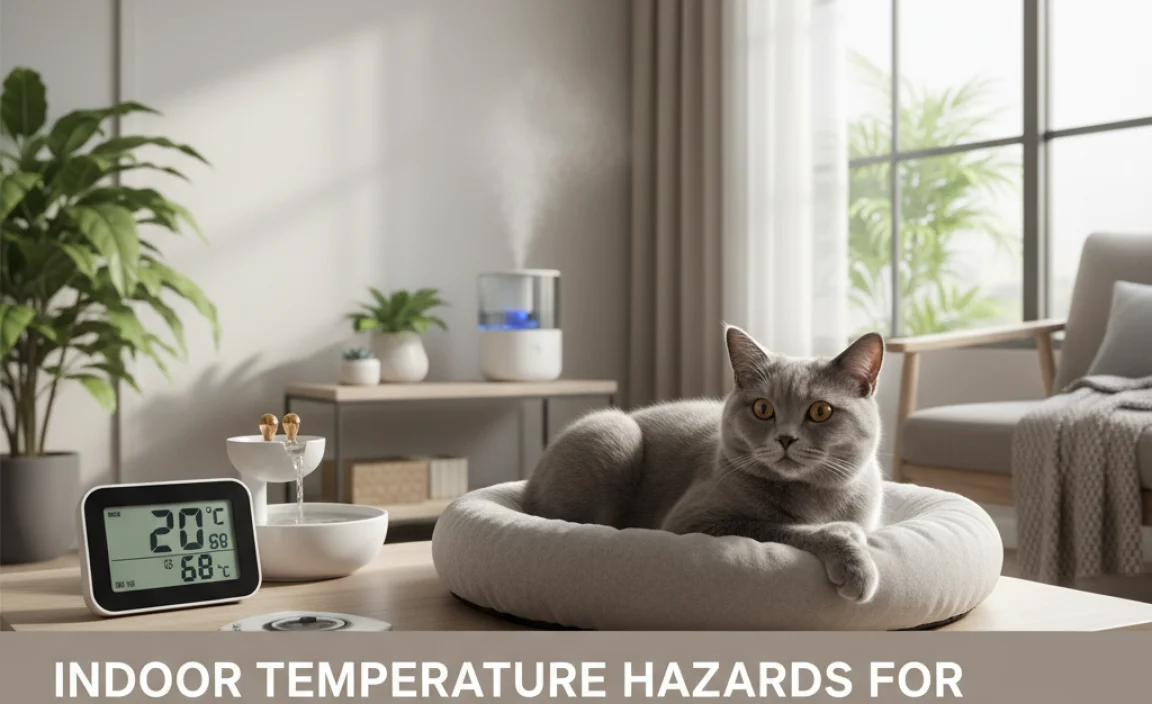
Maintaining a comfortable and safe indoor environment for your British Shorthair involves a combination of temperature control, proper ventilation, and thoughtful adjustments to their living space. By understanding and addressing these factors, you can ensure your cat remains happy and healthy year-round.
Temperature Control Tips
Effective temperature control is crucial for your British Shorthair’s well-being:
- Thermostat Settings: Keep your thermostat set between 68°F and 78°F (20°C and 26°C).
- Air Conditioning: Use air conditioning during hot weather to maintain a consistent temperature.
- Heating: Ensure your heating system is working efficiently during cold weather.
- Programmable Thermostats: Use a programmable thermostat to adjust the temperature automatically based on the time of day.
- Regular Maintenance: Schedule regular maintenance for your HVAC system to ensure it operates efficiently.
Ventilation and Air Quality
Proper ventilation is essential for maintaining good air quality and preventing temperature extremes:
- Open Windows: Open windows periodically to allow fresh air to circulate, but ensure it’s safe and your cat cannot escape.
- Air Purifiers: Use air purifiers to remove dust, allergens, and pollutants from the air.
- Avoid Drafts: Ensure there are no drafts near your cat’s resting areas.
- Humidifiers/Dehumidifiers: Use humidifiers or dehumidifiers to maintain optimal humidity levels, especially during dry or humid seasons.
- Regular Cleaning: Clean your home regularly to reduce dust and allergens.
Adjusting the Living Space for Different Seasons
Adapt your cat’s living space to suit the changing seasons:
- Summer Adjustments:
- Provide shaded resting areas.
- Use cooling mats.
- Ensure access to fresh water.
- Winter Adjustments:
- Provide warm, cozy bedding.
- Insulate cat houses if your cat spends time outdoors.
- Ensure there are no drafts near resting areas.
The Importance of Humidity
Humidity plays a significant role in your British Shorthair’s comfort. Too much or too little humidity can exacerbate temperature-related issues.
- Optimal Humidity Levels: Aim for a humidity level between 30% and 50%.
- High Humidity: Can make it harder for your cat to cool down in warm weather.
- Low Humidity: Can lead to dry skin and respiratory issues.
- Humidifiers: Use humidifiers to increase humidity during dry winter months.
- Dehumidifiers: Use dehumidifiers to reduce humidity during humid summer months.
- Monitor Humidity Levels: Use a hygrometer to monitor humidity levels in your home.
Special Considerations for Kittens and Senior Cats
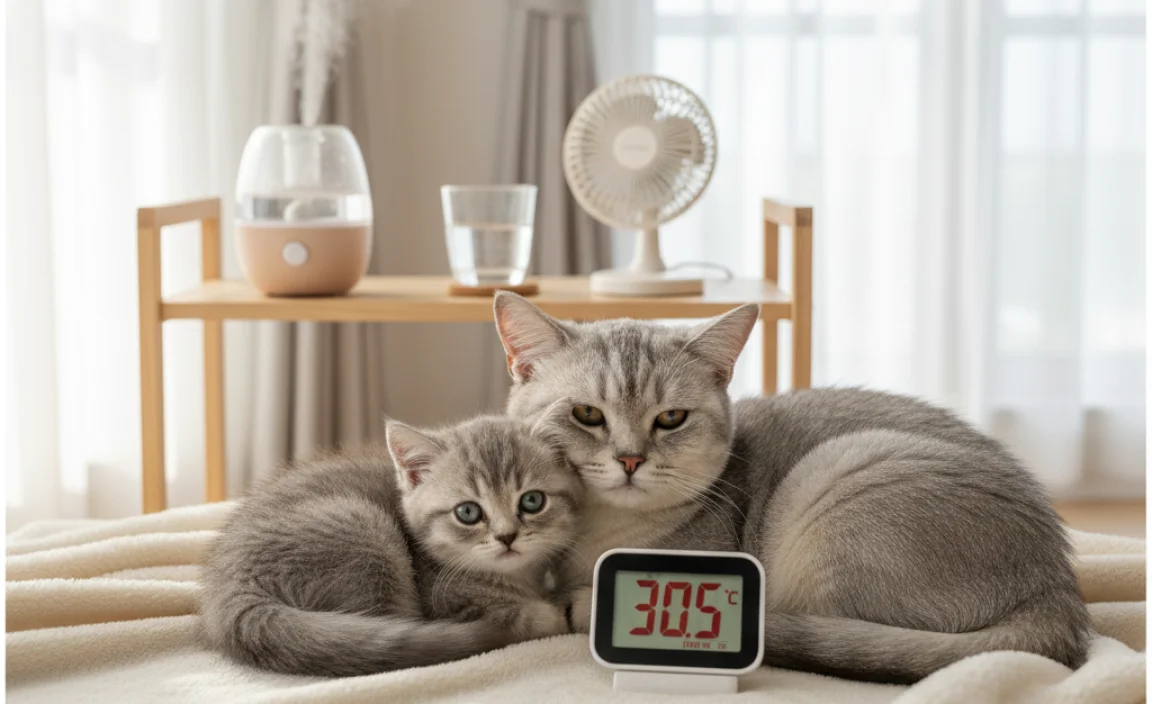
Kittens and senior British Shorthairs require extra attention when it comes to temperature regulation. Their bodies are more vulnerable to temperature extremes, making them more susceptible to overheating and hypothermia.
Temperature Needs of Kittens
Kittens have a harder time regulating their body temperature due to their underdeveloped systems. Here’s what to keep in mind:
- Higher Temperatures: Kittens need slightly warmer temperatures than adult cats, ideally between 70°F and 80°F (21°C and 27°C).
- Warm Bedding: Provide warm, soft bedding in a draft-free area.
- Heating Pads: Use a pet-safe heating pad under their bedding, but ensure they can move away from the heat if they get too warm.
- Monitor Closely: Check kittens frequently for signs of overheating or hypothermia.
- Avoid Chilling: After bathing, dry kittens thoroughly to prevent chilling.
Temperature Needs of Senior Cats
Senior cats often have reduced mobility and may have underlying health conditions that make them more sensitive to temperature changes:
- Warmer Temperatures: Senior cats may prefer slightly warmer temperatures, around 70°F to 75°F (21°C to 24°C).
- Joint Support: Warmth can help ease joint pain and stiffness.
- Comfortable Bedding: Provide orthopedic bedding in a warm, draft-free area.
- Monitor Closely: Regularly check senior cats for signs of discomfort or temperature-related issues.
- Regular Vet Checks: Ensure senior cats have regular veterinary check-ups to monitor their overall health.
Adjusting Care Based on Life Stage
Here’s a quick comparison of temperature-related care adjustments for kittens and senior cats:
| Life Stage | Ideal Temperature | Bedding | Monitoring | Additional Care |
|---|---|---|---|---|
| Kittens | 70°F – 80°F (21°C – 27°C) | Warm, soft bedding; pet-safe heating pad | Frequent checks for overheating or hypothermia | Dry thoroughly after bathing |
| Senior Cats | 70°F – 75°F (21°C – 24°C) | Orthopedic bedding in a draft-free area | Regular checks for discomfort or temperature-related issues | Regular veterinary check-ups |
Recognizing and Addressing Heatstroke and Hypothermia
Heatstroke and hypothermia are both serious conditions that require immediate attention. Knowing how to recognize and respond to these emergencies can be life-saving for your British Shorthair.
Detailed Look at Heatstroke
Heatstroke occurs when a cat’s body temperature rises to dangerous levels. Here’s what you need to know:
- Causes: Exposure to high temperatures, lack of shade or water, strenuous activity.
- Symptoms: Excessive panting, drooling, red gums and tongue, lethargy, vomiting, diarrhea, seizures.
- Immediate Action:
- Move to a cooler area.
- Apply cool water to ears, paws, and belly.
- Offer small amounts of cool water.
- Fan the cat.
- Seek immediate veterinary care.
- Veterinary Treatment: May include IV fluids, oxygen therapy, and monitoring.
Detailed Look at Hypothermia
Hypothermia occurs when a cat’s body temperature drops too low. Here’s what you need to know:
- Causes: Exposure to cold temperatures, wet fur, inadequate shelter.
- Symptoms: Shivering, lethargy, muscle stiffness, pale gums, slow breathing, cold ears and paws, unresponsiveness.
- Immediate Action:
- Move to a warm area.
- Wrap in a warm blanket.
- Warm towels in the dryer and wrap around the cat.
- Offer small amounts of warm water or diluted chicken broth.
- Seek immediate veterinary care.
- Veterinary Treatment: May include warming IV fluids, oxygen therapy, and monitoring.
When to Seek Veterinary Care
It’s always best to err on the side of caution. Seek veterinary care immediately if your British Shorthair shows any signs of heatstroke or hypothermia. These conditions can quickly become life-threatening, and prompt treatment can significantly improve their chances of recovery.
Frequently Asked Questions (FAQ)
What is the ideal temperature for my British Shorthair?
The ideal indoor temperature for a British Shorthair is between 68°F and 78°F (20°C and 26°C). This range is generally comfortable for most cats and helps prevent overheating or hypothermia.
How can I tell if my cat is too hot?
Signs of overheating include excessive panting, lethargy, drooling, red gums and tongue, and restlessness. If you notice these signs, move your cat to a cooler area and offer them water.
What should I do if my cat is shivering?
Shivering is a sign that your cat is too cold. Move them to a warm area, wrap them in a blanket, and offer them warm fluids. If shivering persists, consult your veterinarian.
Are kittens more sensitive to temperature changes?
Yes, kittens have a harder time regulating their body temperature and are more sensitive to both heat and cold. Keep kittens in a slightly warmer environment, around 70°F to 80°F (21°C to 27°C).
Can cats get sunburned indoors?
Yes, cats can get sunburned, especially on areas with less fur, like their ears and nose. Use pet-safe sunscreen or provide shade to protect them from direct sunlight.
How often should I groom my British Shorthair to help with temperature regulation?
Regular grooming, ideally a few times a week, helps remove loose fur that can trap heat in the summer and prevents matting, which can reduce insulation in the winter. This is especially important during shedding seasons.
Is it safe to leave my cat in a car?
Never leave your cat in a car, especially during warm weather. Cars can heat up quickly, leading to heatstroke. Even on mild days, the temperature inside a car can become dangerously high in a short amount of time.
Conclusion
Maintaining a comfortable indoor temperature is essential for the health and well-being of your British Shorthair. By understanding the breed’s unique needs and taking proactive measures, you can protect your feline friend from the dangers of overheating and hypothermia. Pay close attention to their behavior, adjust their environment as needed, and always seek veterinary care if you suspect a temperature-related emergency. With a little care and attention, you can ensure your British Shorthair remains happy, healthy, and purr-fectly comfortable all year round. After all, a comfortable cat is a happy cat, and a happy cat makes a happy home.



